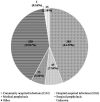Antibiotic Consumption in Hospitals and Resistance Rate of Klebsiella pneumoniae and Escherichia coli in Montenegro
- PMID: 34177057
- PMCID: PMC8212642
- DOI: 10.20471/acc.2020.59.03.11
Antibiotic Consumption in Hospitals and Resistance Rate of Klebsiella pneumoniae and Escherichia coli in Montenegro
Abstract
Inappropriate use of antibiotics leads to an increase in antibiotic resistance. Infections caused by antibiotic-resistant gram-negative bacteria are a serious threat to public health. This study aimed to compare data on inpatient antibiotic consumption with antimicrobial resistance (AMR) rate of Klebsiella pneumoniae and Escherichia coli invasive strains in Montenegro and provide targets for improving antibiotic use. We used the national data on antibiotic consumption from 2009 to 2015, Point Prevalence Survey data on inpatient antibiotic consumption from 2015, and national AMR data on 79 Klebsiella pneumoniae and 68 Escherichia coli isolates collected from 8 hospitals from 2016 to 2018. The most commonly used antibiotics were third-generation cephalosporins with a median annual consumption of 0.66 DDD/1000/day. Ceftriaxone was the most frequently prescribed antibiotic in the treatment of community/hospital acquired infections and surgical/medical prophylaxis. The highest resistance rates were recorded for Klebsiella pneumoniae to ceftriaxone, ceftazidime and gentamicin (93.59%, 90.79% and 89.87%, respectively), and Escherichia coli to aminopenicillins, ceftriaxone and ceftazidime (89.06%, 70.15% and 61.54%, respectively). High consumption of broad-spectrum antibiotics in Montenegro is accompanied by the high rate of resistance of Klebsiella pneumoniae and Escherichia coli to these agents. Antibiotic misuse demands the introduction of an antimicrobial stewardship program in Montenegrin hospitals.
Keywords: Antibiotics, consumption; Antibiotics, resistance; Escherichia coli; Klebsiella pneumoniae; Montenegro.
Figures



Similar articles
-
Intra-hospital differences in antibiotic use correlate with antimicrobial resistance rate in Escherichia coli and Klebsiella pneumoniae: a retrospective observational study.Antimicrob Resist Infect Control. 2018 Jul 28;7:89. doi: 10.1186/s13756-018-0387-0. eCollection 2018. Antimicrob Resist Infect Control. 2018. PMID: 30069305 Free PMC article.
-
Antimicrobial susceptibility testing and antibiotic consumption results from 16 hospitals in Viet Nam: The VINARES project 2012-2013.J Glob Antimicrob Resist. 2019 Sep;18:269-278. doi: 10.1016/j.jgar.2019.06.002. Epub 2019 Jun 12. J Glob Antimicrob Resist. 2019. PMID: 31201995
-
Association between the rate of third generation cephalosporin-resistant Escherichia coli and Klebsiella pneumoniae and antibiotic consumption based on 143 Chinese tertiary hospitals data in 2014.Eur J Clin Microbiol Infect Dis. 2020 Aug;39(8):1495-1502. doi: 10.1007/s10096-020-03856-1. Epub 2020 Mar 27. Eur J Clin Microbiol Infect Dis. 2020. PMID: 32221726
-
Extended spectrum β-lactamase producing Escherichia coli and Klebsiella pneumoniae: critical tools for antibiotic resistance pattern.J Basic Microbiol. 2017 Jun;57(6):460-470. doi: 10.1002/jobm.201700008. Epub 2017 Apr 11. J Basic Microbiol. 2017. PMID: 28397262 Review.
-
High Reported Rates of Antimicrobial Resistance in Indian Neonatal and Pediatric Blood Stream Infections.J Pediatric Infect Dis Soc. 2017 Sep 1;6(3):e62-e68. doi: 10.1093/jpids/piw092. J Pediatric Infect Dis Soc. 2017. PMID: 28339675 Review.
Cited by
-
Appropriateness of gentamicin therapeutic drug monitoring at a Middle Eastern tertiary hospital setting: a retrospective evaluation and quality audit.J Pharm Policy Pract. 2024 Jul 12;17(1):2375753. doi: 10.1080/20523211.2024.2375753. eCollection 2024. J Pharm Policy Pract. 2024. PMID: 39011355 Free PMC article.
-
Carbapenem-Resistant Enterobacterales in the Western Balkans: Addressing Gaps in European AMR Surveillance Map.Antibiotics (Basel). 2024 Sep 19;13(9):895. doi: 10.3390/antibiotics13090895. Antibiotics (Basel). 2024. PMID: 39335068 Free PMC article. Review.
-
THE USE OF MICROBIOLOGICAL AND LABORATORY DATA IN THE CHOICE OF EMPIRICAL ANTIBIOTIC THERAPY IN PATIENTS UNDERGOING LAPAROSCOPIC CHOLECYSTECTOMY - THE ROLE OF LOCAL ANTIBIOGRAMS.Acta Clin Croat. 2022 Aug;61(2):171-176. doi: 10.20471/acc.2022.61.02.01. Acta Clin Croat. 2022. PMID: 36818920 Free PMC article.
-
COMPARISON OF LAPAROSCOPIC AND OPEN PYELOPLASTY IMPACT ON COMFORT AND SUCCESS: A RETROSPECTIVE, SINGLE CENTER STUDY.Acta Clin Croat. 2023 Apr;62(1):75-81. doi: 10.20471/acc.2023.62.01.09. Acta Clin Croat. 2023. PMID: 38304363 Free PMC article.
References
-
- Versporten A, Zarb P, Caniaux I, Gros MF, Drapier N, Miller M, et al. on behalf of the Global-PPS network. Antimicrobial consumption and resistance in adult hospital inpatients in 53 countries: results of an internet-based global point prevalence survey. Lancet Glob Health. 2018;6(6):e619–29. 10.1016/S2214-109X(18)30186-4 - DOI - PubMed
MeSH terms
Substances
LinkOut - more resources
Full Text Sources
Medical
Research Materials
